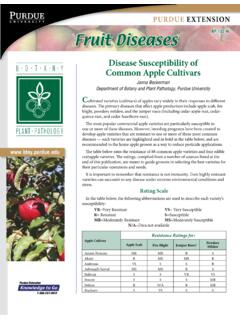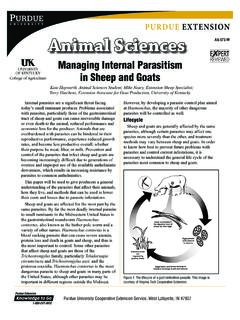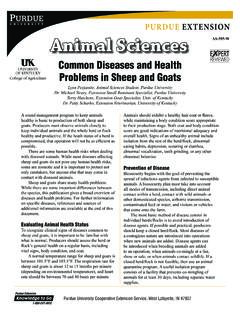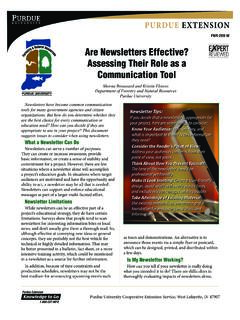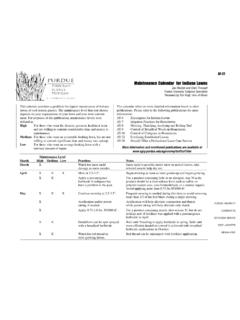Transcription of EC-722 Industry Analysis: The Five Forces - Purdue University
1 Purdue extensionEC-722 Industry analysis : The five ForcesCole Ehmke, Joan Fulton, and Jay AkridgeDepartment of Agricultural EconomicsKathleen Erickson, Erickson CommunicationsSally LintonDepartment of Food ScienceOverview Assessing Your MarketplaceThe economic structure of an Industry is not an accident. Its complexities are the result of long-term social trends and economic Forces . But its effects on you as a business manager are immediate because it determines the competitive rules and strategies you are likely to use. Learning about that structure will provide essential insight for your business strategy. Michael Porter has identified five Forces that are widely used to assess the structure of any Industry . Porter s five Forces are the: Bargaining power of suppliers, Bargaining power of buyers, Threat of new entrants, Threat of substitutes, and Rivalry among , the strength of the five Forces determines the profit potential in an Industry by influencing the prices, costs, and required investments of businesses the elements of return on investment.
2 Stronger Forces are associated with a more challenging business environment. To identify the important structural features of your Industry via the five Forces , you conduct an Industry analysis that answers the question, What are the key factors for competitive success? Using This PublicationThis publication describes five Forces that influence an Industry . The publication includes a set of application questions that will help you evaluate the structure of the Industry you are in or are considering entering. The more you understand about the strength of each force , the better able you will be to respond. The Forces affecting profitability are often beyond your control, so you must choose tactics to respond to the Forces rather than try to change the business environment. This publication offers insight on specific tactics you need for success when facing competitive situations.
3 While you may assess any one force individually, you will gain the most value by assessing all five of the forcesWith each force , a Perspective feature illustrates the force for an Indiana wine entrepreneur by evaluating that market-place. To avoid repetition, we use the word product to mean either a product or a service. Read more about the five Forces in Porter s book, Competitive : Business managers seeking to assess the nature of their marketplaceContent: Presents five Forces that influence the profitability of an industryOutcome: Reader should understand the Forces and be able to counter them with appropriate tactics2 Purdue Extension Knowledge to GoBargaining Power of SuppliersHow Much Power Do Your Suppliers Have Over You?Any business requires inputs labor, parts, raw materials, and services.
4 The cost of your inputs can have a significant effect on your company s profitability. Whether the strength of suppliers represents a weak or a strong force hinges on the amount of bargaining power they can exert and, ultimately, on how they can influence the terms and conditions of transactions in their favor. Suppliers would prefer to sell to you at the highest price possible or provide you with no more services than necessary. If the force is weak, then you may be able to negotiate a favorable business deal for yourself. Conversely, if the force is strong, then you are in a weak position and may have to pay a higher price or accept a lower level of quality or service. Factors Affecting the Bargaining Power of SuppliersSuppliers have the most power when: The input(s) you require are available only from a small number of suppliers.
5 For instance, if you are making computers and need microprocessors, you will have little or no bargaining power with Intel, the world s dominant supplier. The inputs you require are unique, making it costly to switch suppliers. If you use a certain enzyme in a food manufacturing process, changing to another supplier may require you to change your entire manufacturing process. This may be very costly to you, thus you will have less bargaining power with your supplier. Your input purchases don t represent a significant portion of the supplier s business. If the supplier does not depend on your business, you will have less power to negotiate. Of course the opposite is true as well. Wal-Mart has significant negotiating power over its suppliers because it is such a large percentage of suppliers business.
6 Suppliers can sell directly to your customers, bypassing the need for your business. For example, a manufacturer could open its own retail outlet and compete against you. It is difficult for you to switch to another supplier. For example, if you recently invested in a unique inventory and information management system to work effectively with your supplier, it would be expensive for you to switch suppliers. You do not have a full understanding of your supplier s market. You are less able to negotiate if you have little information about market demand, prices, and supplier s costs. Reducing the Bargaining Power of SuppliersMost businesses don t have the resources to produce their own inputs. If you are in this position, then you might consider forming a partnership with your supplier.
7 This can result in a more even distribution of power. For instance, Dell Computer uses partnering with its components suppliers as a key strategy to be the low-cost/high-quality leader in the market. This can be mutually beneficial for both supplier and buyer if they can: Reduce inventory costs by providing just-in-time deliveries, Enhance the value of goods and services supplied by making effective use of information about customer needs and preferences, and Speed the adoption of new option may be to increase your power by forming a buying group of small producers to buy as one large-volume customer. If you have the resources, you may choose to integrate back and produce your own inputs by purchasing one of your key suppliers or doing the production yourself. 3 Purdue Extension Knowledge to Go1.
8 Are there a large number of potential input suppliers? The greater number of suppliers of your needed inputs, the more control you will have. 2. Are the products that you need to purchase for your business ordinary? You have more control when the products you need from a supplier are not Do your purchases from suppliers represent a large portion of their business? If your purchases are a relatively large portion of your supplier s business, you will have more power to lower costs or improve product NoYes NoYes NoYes NoYes NoYes No4. Would it be difficult for your suppliers to enter your business, sell directly to your customers, and become your direct competitor? The easier it is to start a new business, the more likely it is that you will have competitors.
9 5. Can you easily switch to substitute products from other suppliers? If it is relatively easy to switch to substitute products, you will have more negotiating room with your Are you well informed about your supplier s product and market? If the market is complicated or hard to understand, you have less bargaining power with your suppliers. Self Assessment Bargaining Power of SuppliersThis is a short scorecard to help you assess your business position in the marketplace. Read each of the questions, and respond with Yes or No in the space provided. Yes indicates a favorable competitive environment for your business. No indicates a negative situation. Use the insight you gain to develop effective tactics for countering or taking advantage of the on Bargaining Power of SuppliersFor an Indiana winery, one of the main supply decisions lies with the key product ingredients winegrapes and juice.
10 Wineries have several options, including owning the vineyard, purchasing grapes, or purchasing juice. An overabundance of winegrapes and juice from the West Coast of the , for instance, enhances Indiana wineries negotiating power with grape and juice suppliers. However, the bargaining power of Indiana wineries is generally weakened due to lack of winegrape growing experience. If the winery needs a specific grape variety for a particular wine , then the manager needs to be concerned about the supply and demand for the product. As supply becomes short, the manager will find that suppliers have increasing bargaining power. Raw materials for wine production are commodity items that are very cyclical in price, quality, and availability. There are times when high-quality grapes can be bought for low prices (over supply) and other times when particular grape varieties or juice are almost non-existent.
